Quad-Band 1 × 4 Linear MIMO Antenna for Millimeter-Wave, Wearable and Biomedical Telemetry Applications
Abstract
1. Introduction
2. Antenna Design Evolution and Analysis
3. 1 × 4 mm-Wave Linear MIMO Array Antenna Design and Measurement
4. 1 × 4 mm-Wave Linear MIMO Array Antenna Gain, Radiation Efficiency and Radiation Pattern
5. Diversity Parameters of mm-Wave 1 × 4 Linear MIMO Array Antenna
6. Bending Analysis of mm-Wave Linear MIMO Array Antenna
7. Specific Absorption Ratio (SAR) Analysis
8. Link Budget Study
9. Conclusions
Author Contributions
Funding
Institutional Review Board Statement
Informed Consent Statement
Data Availability Statement
Conflicts of Interest
References
- Güler, C.; Bayer Keskin, S.E. A novel high isolation 4-port compact MIMO antenna with DGS for 5G applications. Micromachines 2023, 14, 1309. [Google Scholar] [CrossRef] [PubMed]
- Awan, W.A.; Soruri, M.; Alibakhshikenari, M.; Limiti, E. On-demand frequency switchable antenna array operating at 24.8 and 28 GHz for 5G high-gain sensors applications. Prog. Electromagnet. Res. M 2022, 108, 163–173. [Google Scholar] [CrossRef]
- Sharma, P.; Tiwari, R.N.; Singh, P.; Kumar, P.; Kanaujia, B.K. MIMO antennas: Design approaches, techniques and applications. Sensors 2022, 22, 7813. [Google Scholar] [CrossRef] [PubMed]
- Armghan, A.; Lavadiya, S.; Udayaraju, P.; Alsharari, M.; Aliqab, K.; Patel, S.K. Sickle-shaped high gain and low profile based four port MIMO antenna for 5G and aeronautical mobile communication. Sci. Rep. 2023, 13, 15700. [Google Scholar] [CrossRef] [PubMed]
- Ali, W.A.W.; Ibrahim, A.A.; Ahmed, A.E. Dual-band millimeter wave 2 × 2 MIMO slot antenna with low mutual coupling for 5G networks. Wirel. Pers. Commun. 2023, 129, 2959–2976. [Google Scholar] [CrossRef]
- Esmail, B.A.F.; Koziel, S. Design and optimization of metamaterial-based dual-band 28/38 GHz 5G MIMO antenna with modified ground for isolation and bandwidth improvement. IEEE Antennas Wirel. Propag. Lett. 2023, 22, 1069–1073. [Google Scholar] [CrossRef]
- Elabd, R.H.; Al-Gburi, A.J.A. Super-compact 28/38 GHz 4-port MIMO antenna using metamaterial-inspired EBG structure with SAR analysis for 5G cellular devices. J. Infrared Millim. Terahertz Waves 2024, 45, 35–65. [Google Scholar] [CrossRef]
- Elsharkawy, R.R.; Hussein, K.F.A.; Farahat, A.E. Dual-band (28/38 GHz) compact MIMO antenna system for millimeter-wave applications. J. Infrared Millim. Terahertz Waves 2023, 44, 1016–1037. [Google Scholar] [CrossRef]
- Ud Din, I.; Alibakhshikenari, M.; Virdee, B.S.; Jayanthi, R.K.R.; Ullah, S.; Khan, S.; See, C.H.; Golunski, L.; Koziel, S. Frequency-selective surface-based MIMO antenna array for 5G millimeter-wave applications. Sensors 2023, 23, 7009. [Google Scholar] [CrossRef]
- Khan, D.; Ahmad, A.; Choi, D.Y. Dual-band 5G MIMO antenna with enhanced coupling reduction using metamaterials. Sci. Rep. 2024, 14, 96. [Google Scholar] [CrossRef]
- Anushkannan, N.K.; Almawgani, A.H.M.; Kumar, U.A.; Hindi, A.T. CSRR backed compact two-port, dual-band MIMO antenna for mm-wave applications. Wirel. Netw. 2024, 30, 1857–1867. [Google Scholar] [CrossRef]
- Khan, J.; Ullah, S.; Ali, U.; Tahir, F.A.; Peter, I.; Matekovits, L. Design of a millimeter-wave MIMO antenna array for 5G communication terminals. Sensors 2022, 22, 2768. [Google Scholar] [CrossRef] [PubMed]
- Munir, M.E.; Kiani, S.H.; Savci, H.S.; Marey, M.; Khan, J.; Mostafa, H.; Parchin, N.O. A four element mm-wave MIMO antenna system with wide-band and high isolation characteristics for 5G applications. Micromachines 2023, 14, 776. [Google Scholar] [CrossRef] [PubMed]
- Liang, Q.; Aliakbari, H.; Lau, B.K. Co-designed millimeter-wave and sub-6 GHz antenna for 5G smartphones. IEEE Antennas Wirel. Propag. Lett. 2022, 21, 1995–1999. [Google Scholar] [CrossRef]
- Liu, P.; Zhu, X.W.; Zhang, Y.; Wang, X.; Yang, C.; Jiang, Z.H. Patch antenna loaded with paired shorting pins and H-shaped slot for 28/38 GHz dual-band MIMO applications. IEEE Access 2020, 8, 23705–23712. [Google Scholar] [CrossRef]
- Tiwari, R.N.; Singh, P.; Barman, P.B. Triple-band gap coupled 4×4 MIMO antenna in mm-wave for high data rate and IoT applications. Emergent Converging Technol. Biomed. Syst. Lect. Notes Electr. Eng. 2024, 1116, 499–509. [Google Scholar]
- Wu, R.; Dong, J.; Wang, M. Wearable polarization conversion metasurface MIMO antenna for biomedical applications in 5 GHz WBAN. Biosensors 2023, 13, 73. [Google Scholar] [CrossRef]
- Ullah, U.; Koziel, S.; Dabrowska, A.P. Design and characterization of a planar structure wideband millimeter-wave antenna with wide beamwidth for wearable off-body communication applications. IEEE Antennas Wirel. Propag. Lett. 2022, 21, 2070–2074. [Google Scholar] [CrossRef]
- Tiwari, R.N.; Kaim, V.; Singh, P.; Khan, T.; Kanaujia, B.K. Semi-flexible diversified circularly polarized millimeter-wave MIMO antenna for wearable biotechnologies. IEEE Trans. Antennas Propag. 2023, 71, 3968–3982. [Google Scholar] [CrossRef]
- Tiwari, R.N.; Sharma, D.; Singh, P.; Kumar, P. A flexible dual-band 4 × 4 MIMO antenna for 5G mm-wave 28/38 GHz wearable applications. Sci. Rep. 2024, 14, 14324. [Google Scholar] [CrossRef]
- Vallappil, A.K.; Khawaja, B.A.; Rahim, M.K.A.; Iqbal, M.N.; Chattha, H.T. Metamaterial-inspired electrically compact triangular antennas loaded with CSRR and 3 × 3 cross-slots for 5G indoor distributed antenna systems. Micromachines 2022, 13, 198. [Google Scholar] [CrossRef] [PubMed]
- Rappaport, S.; Xing, Y.; MacCartney, G.R.; Molisch, A.F.; Mellios, E.; Zhang, J. Overview of millimeter wave communications for fifth-generation (5G) wireless networks-with a focus on propagation models. IEEE Trans. Antennas Propag. 2017, 65, 6213–6230. [Google Scholar] [CrossRef]
- Taga, T. Analysis for mean effective gain of mobile antennas in land mobile radio environments. IEEE Trans. Vehicul. Technol. 1990, 39, 117–131. [Google Scholar] [CrossRef]
- Manteghi, M.; Rahmat-Samii, Y. Multiport characteristics of a wideband cavity backed annular patch antenna for multipolarization operations. IEEE Trans. Antennas Propag. 2005, 53, 466–474. [Google Scholar] [CrossRef]
- Shin, H.; Lee, J.H. Capacity of multiple-antenna fading channels: Spatial fading correlation, double scattering, and keyhole. IEEE Trans. Inform. Theory 2003, 49, 2636–2647. [Google Scholar] [CrossRef]
- Tiwari, R.N.; Singh, P.; Kanaujia, B.K.; Srivastava, K. Neutralization technique based two and four port high isolation MIMO antennas for UWB communication. AEU-Int. J. Electron. Commun. 2019, 110, 152828. [Google Scholar] [CrossRef]
- International Commission on Non-Ionizing Radiation Protection (ICNIRP). Statement on the Guidelines for limiting exposure to time-varying electric, magnetic and electromagnetic fields (up to 300 GHz). Health Phys. 2009, 97, 257–258. [Google Scholar] [CrossRef] [PubMed]
- C95.1-2005; IEEE Standard for Safety Levels with Respect to Human Exposure to Radio Frequency Electromagnetic Fields, 3 kHz to 300 GHz. Institute of Electrical and Electronics Engineers (IEEE): New York, NY, USA, 2005.
- Mazar, H.M. EMF, New ICNIRP Guidelines and IEEE C95. 1–2019 Standard: Differences and Similarities. In Proceedings of the International Conference: EMF and the Future of Telecommunications, Warsaw, Poland, 3–4 December 2019; Volume 5, pp. 1–30. [Google Scholar]
- Sim, K.H.; Hwang, M.S.; Kim, S.Y.; Lee, H.H.; Chang, J.Y.; Lee, M.K. The appropriateness of the length of insulin needles based on determination of skin and subcutaneous fat thickness in the abdomen and upper arm in patients with type 2 diabetes. Diabetes Metab. J. 2014, 38, 120–133. [Google Scholar] [CrossRef] [PubMed]
- Shah, S.R.M.; Asan, N.B.; Velander, J.; Ebrahimizadeh, J.; Perez, M.D.; Mattsson, V.; Blokhuis, T.J.; Augustine, R. Analysis of thickness variation in biological tissues using microwave sensors for health monitoring applications. IEEE Access 2019, 7, 156033–156043. [Google Scholar]
- Available online: https://itis.swiss/virtual-population/tissue-properties/database/dielectric-properties (accessed on 29 May 2024).
- Rajagopalan, H.; Rahmat-Samii, Y. Wireless medical telemetry characterization for ingestible capsule antenna designs. IEEE Antennas Wirel. Propag. Lett. 2012, 11, 1679–1682. [Google Scholar] [CrossRef]
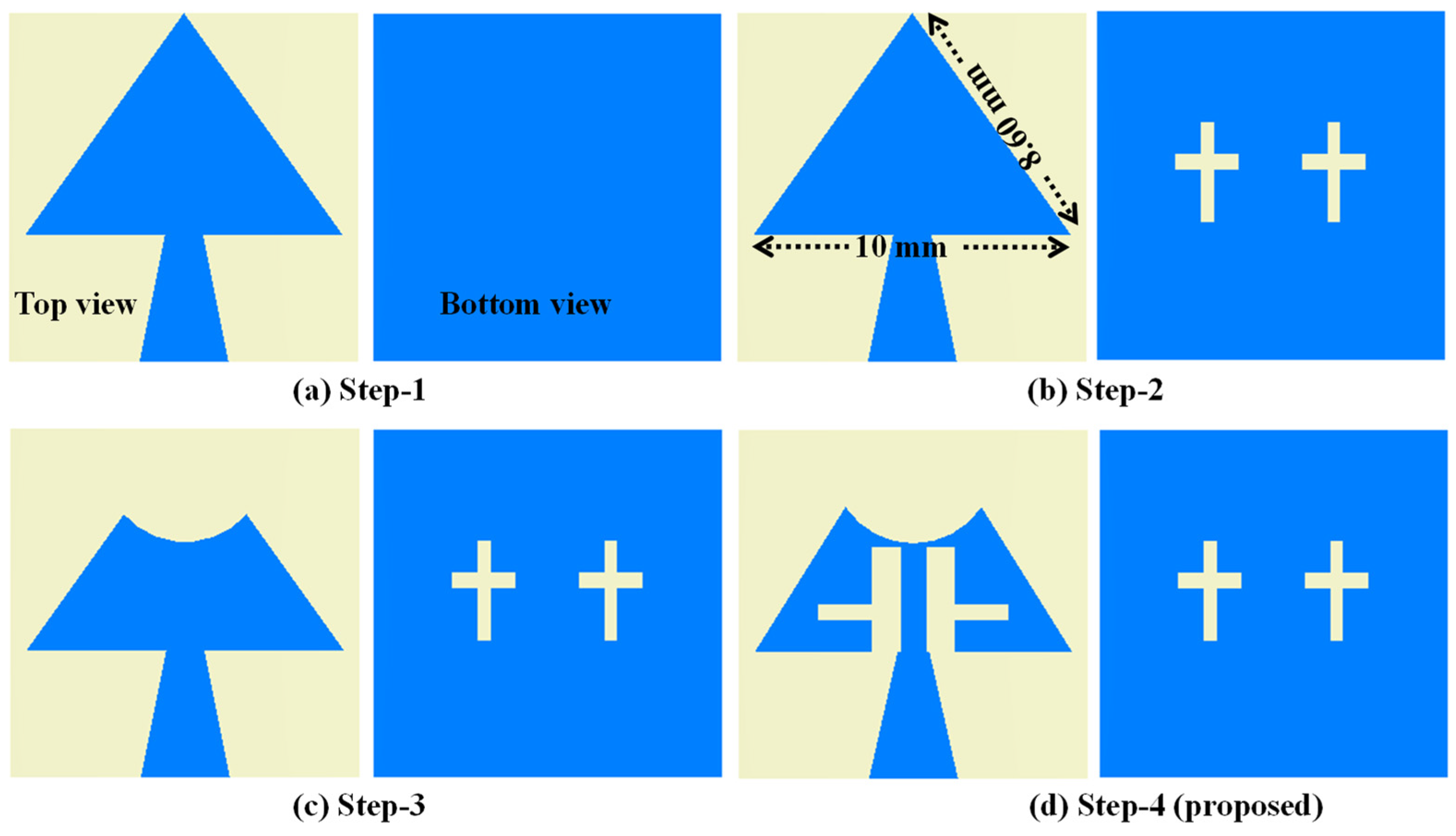






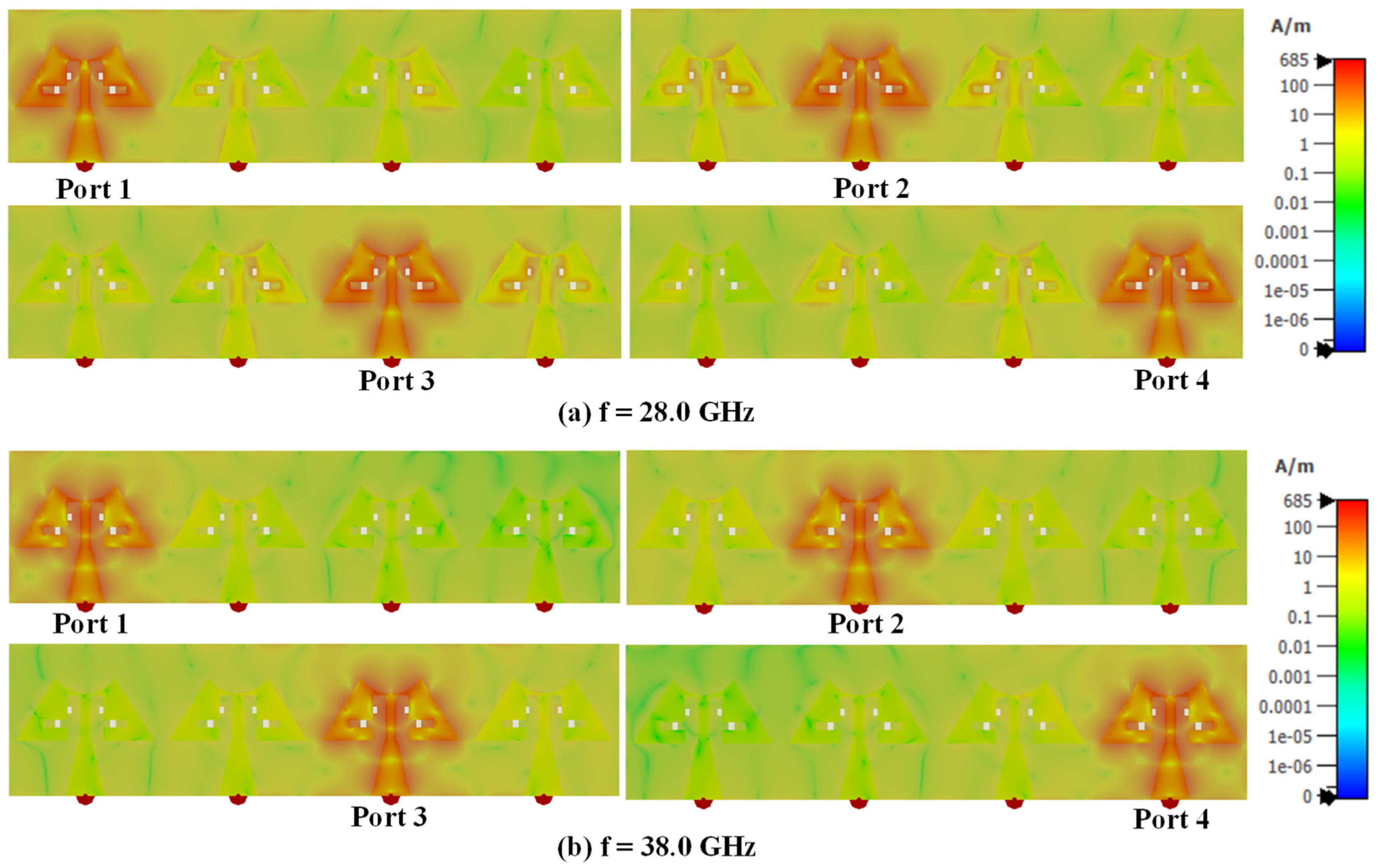

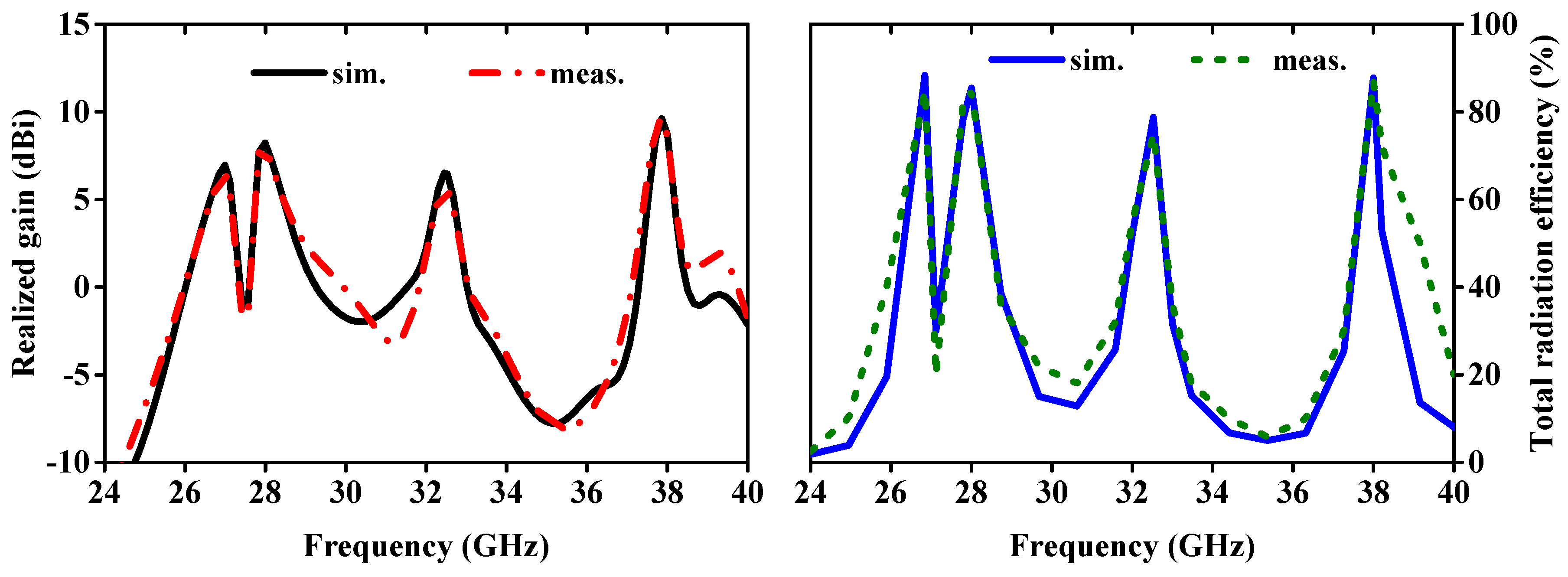

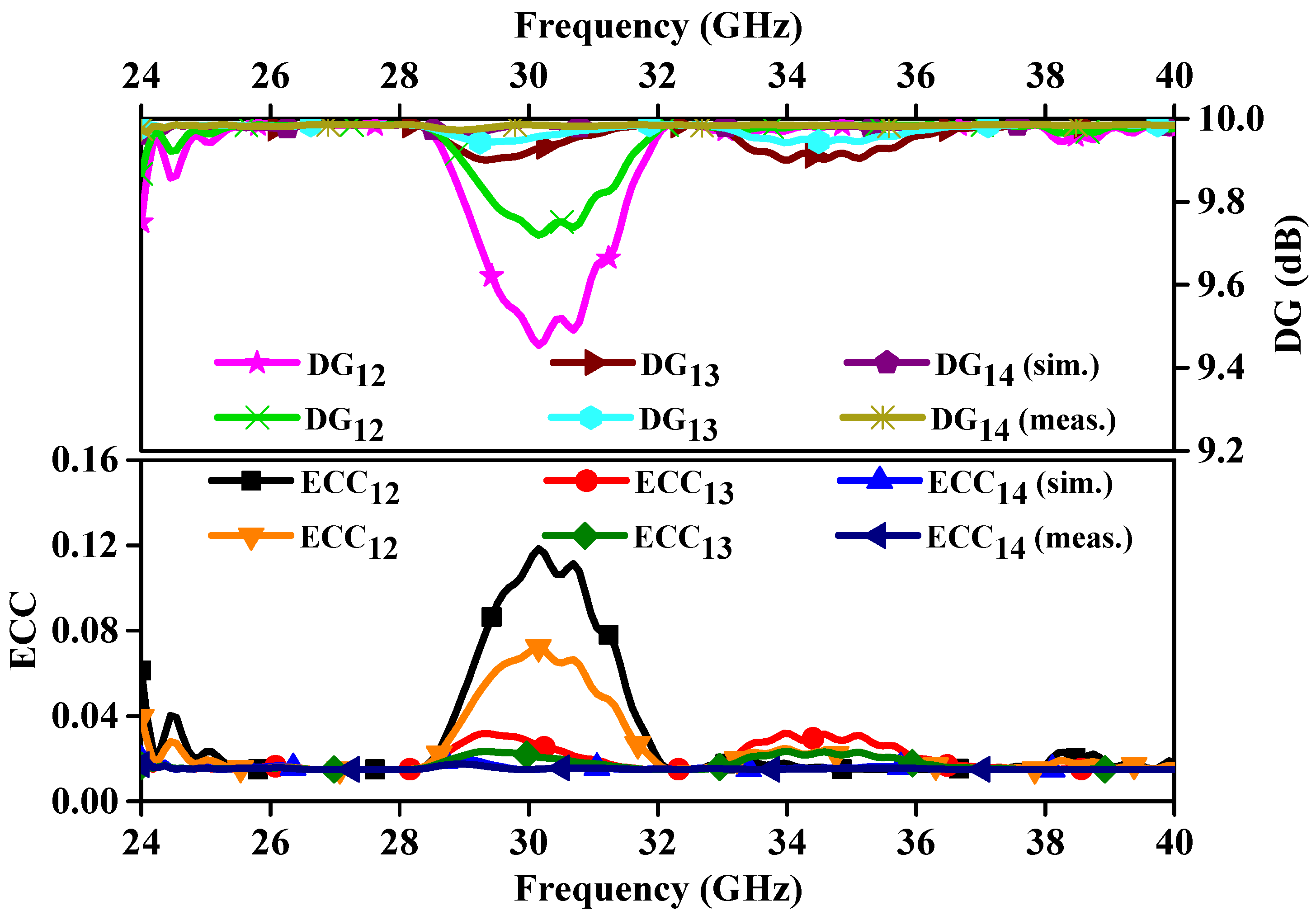

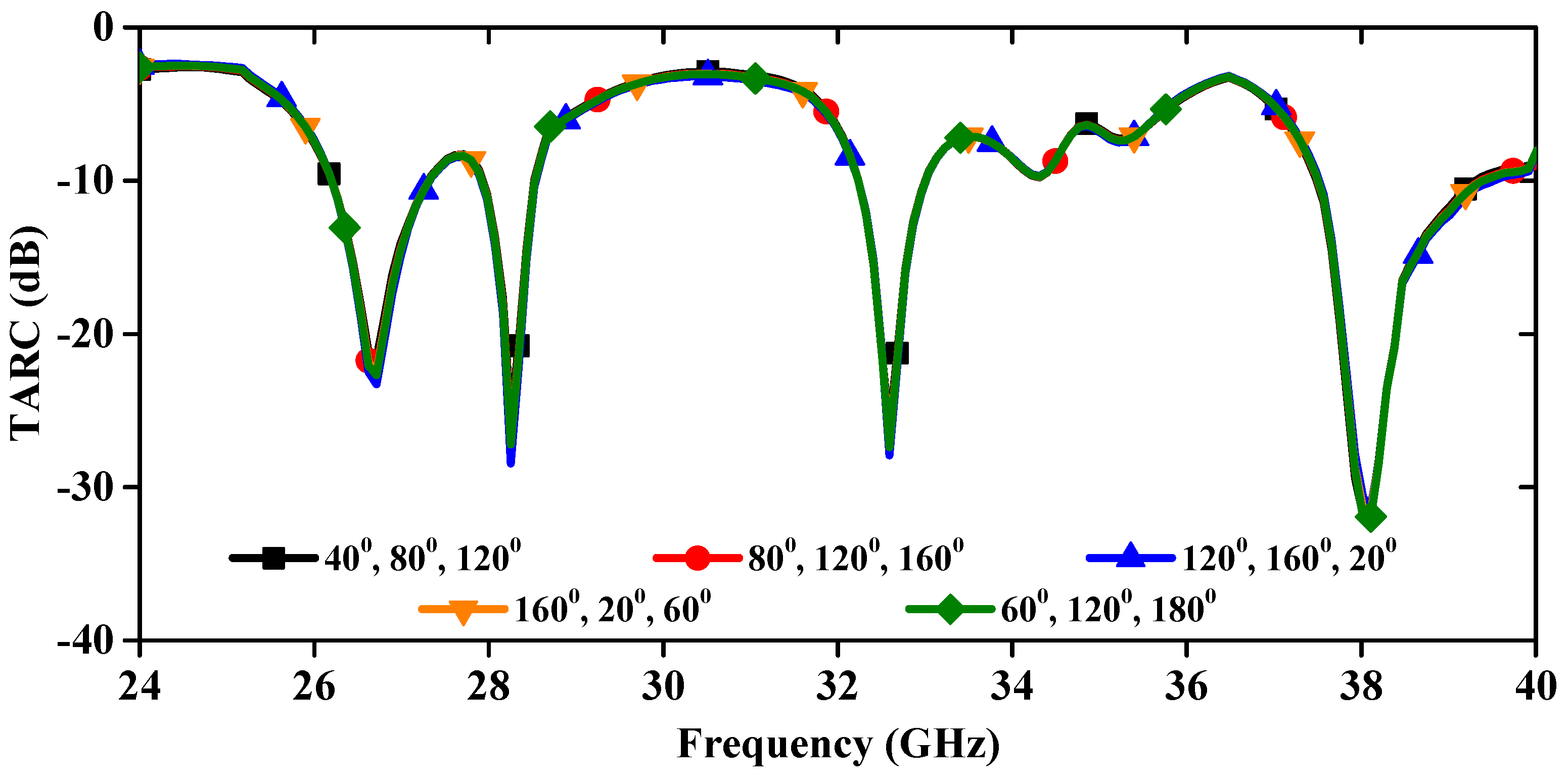


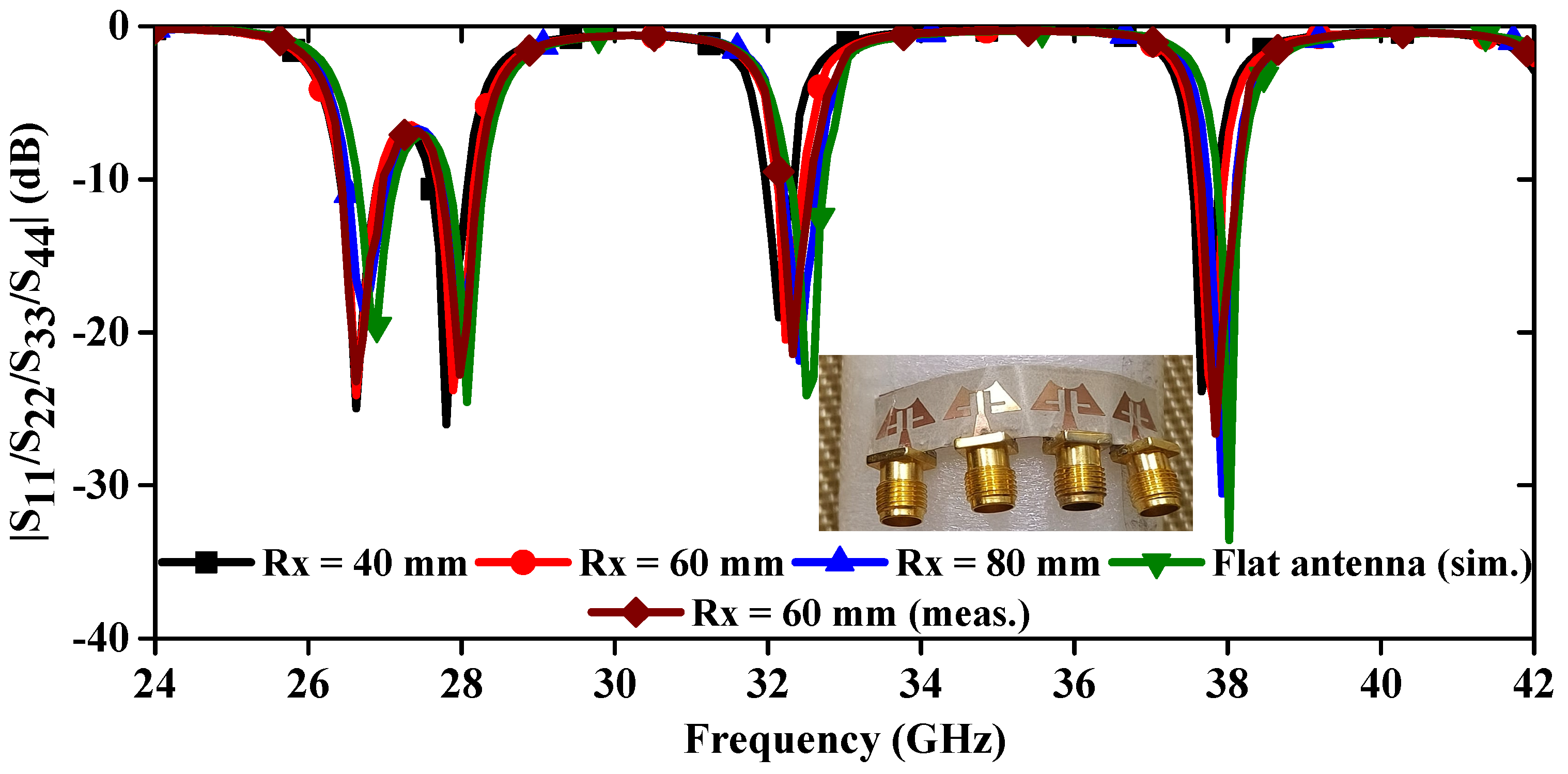

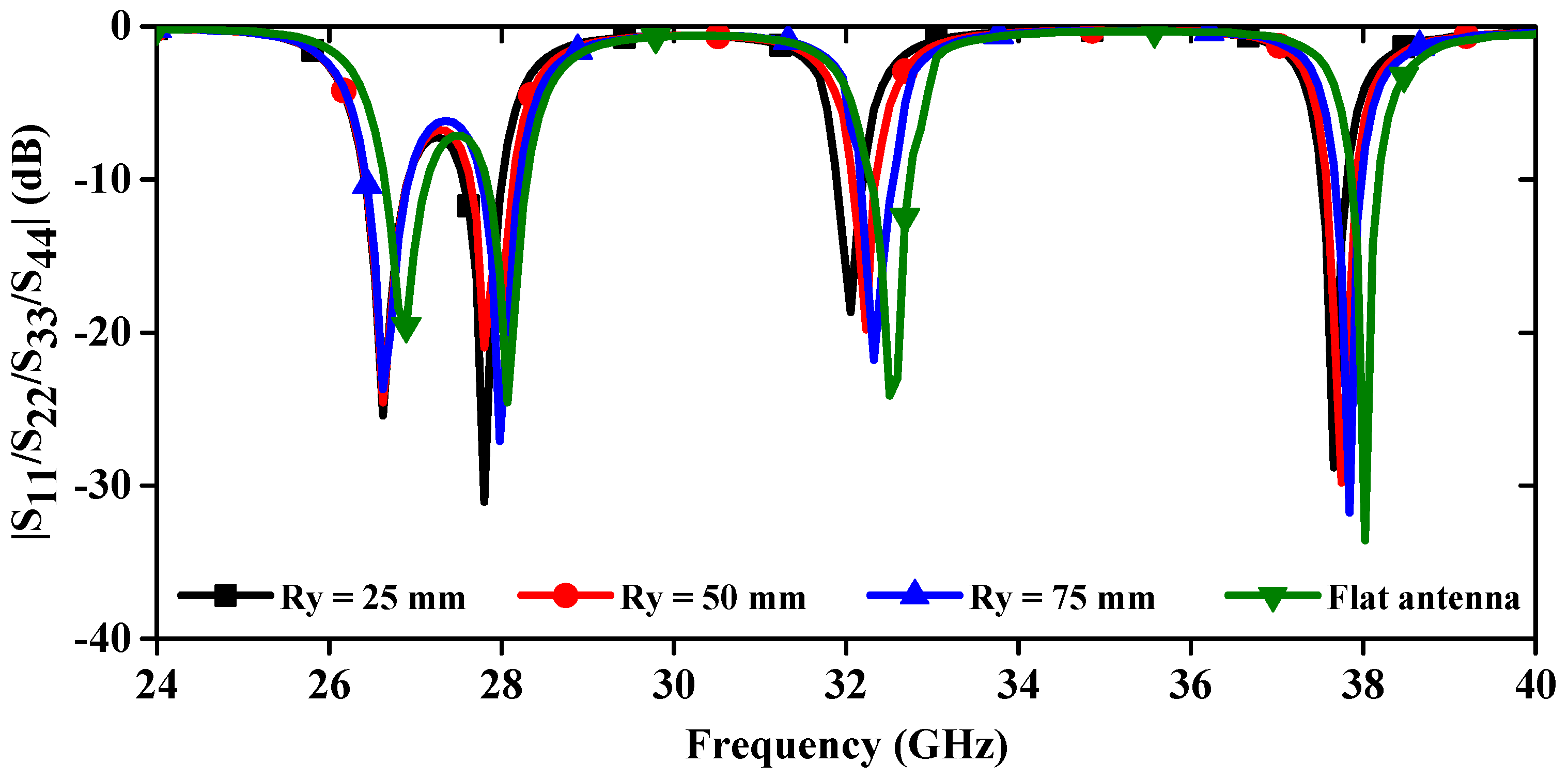
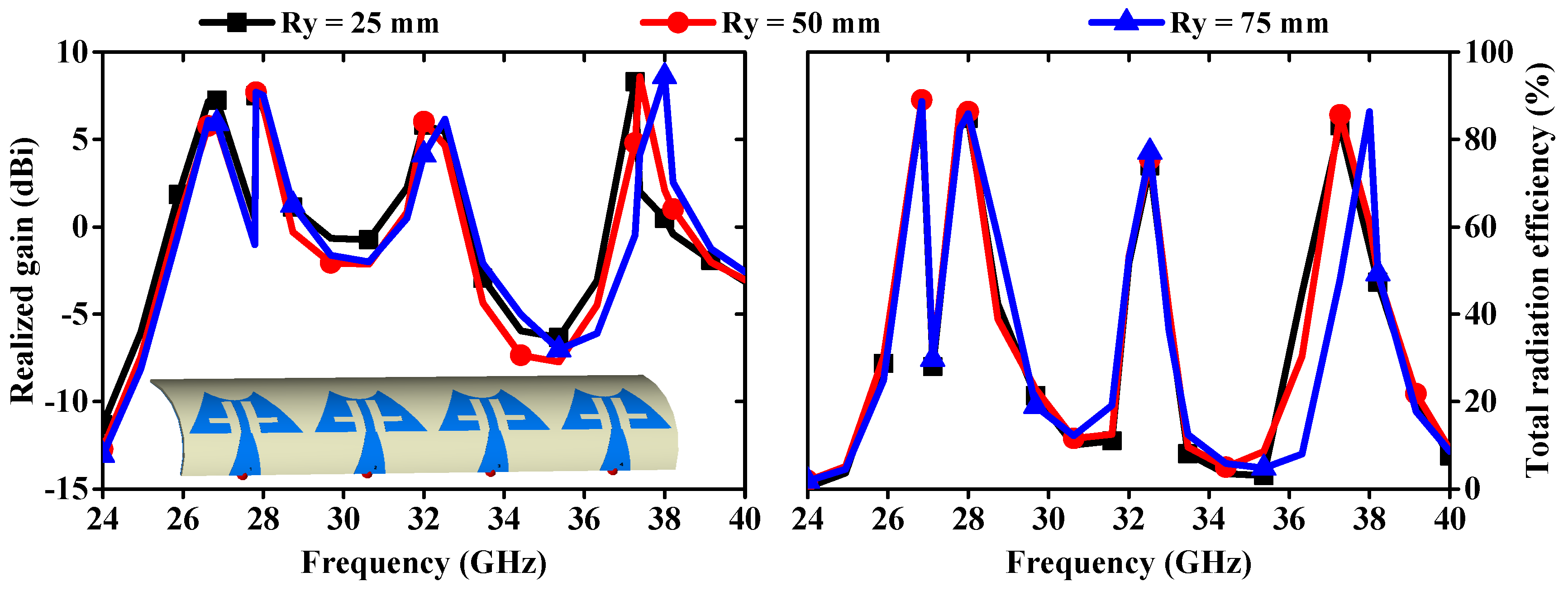
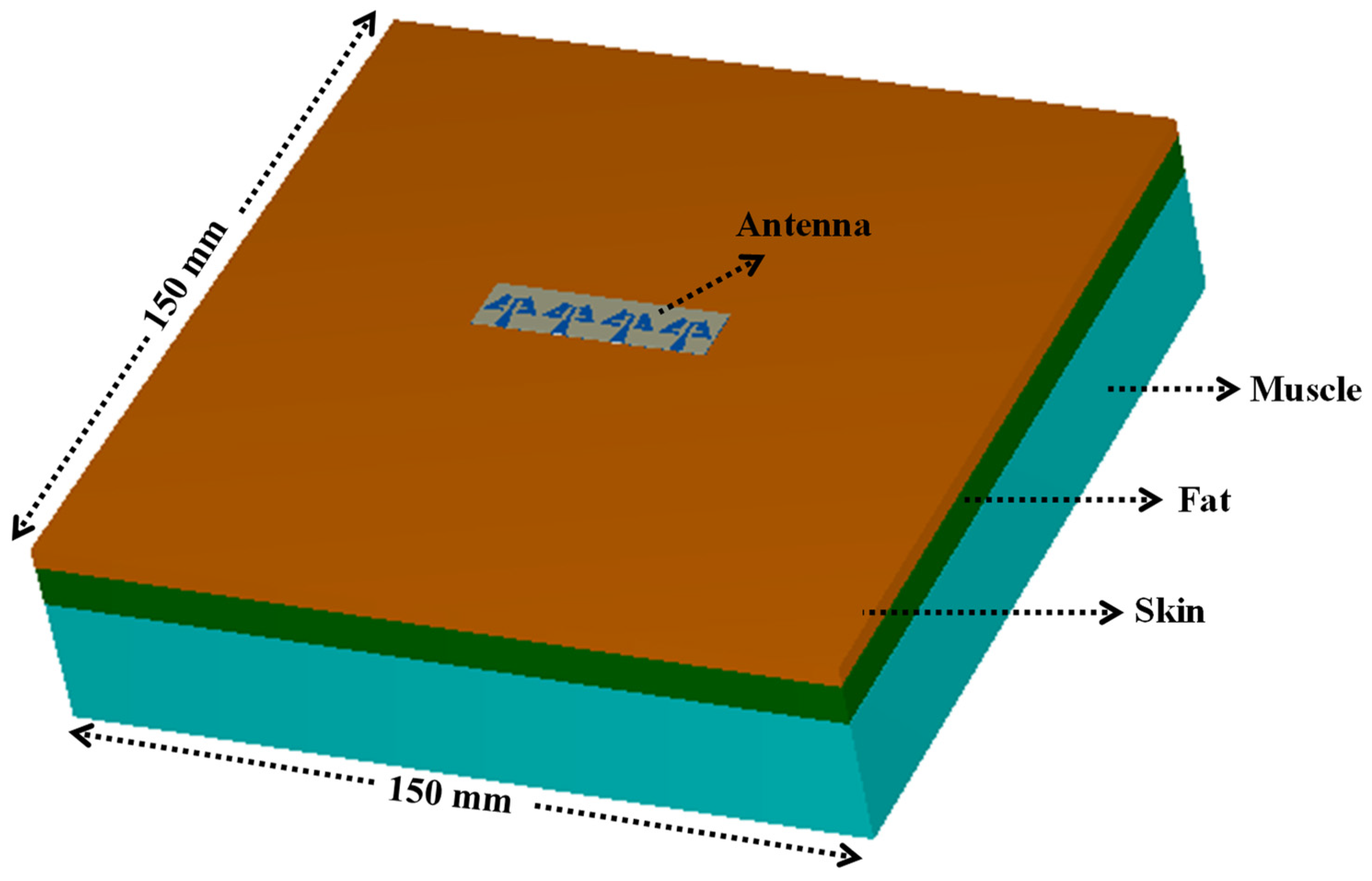


| Parameter | ||||||||||
| Value (mm) | 11.0 | 11.0 | 2.8 | 4.1 | 1.0 | 3.7 | 5.39 | 3.3 | 0.9 | 1.7 |
| Parameter | ||||||||||
| Value (mm) | 0.5 | 1.8 | 2.58 | 11.0 | 11.0 | 4.35 | 1.65 | 0.5 | 1.0 | 2.0 |
| Parameter | - | |||||||||
| Value (mm) | 0.8 | 0.4 | 0.8 | 11.0 | 44.0 | 1.0 | 11.0 | 44.0 | 5.0 | - |
| 28.0 GHz | 38.0 GHz | |||
|---|---|---|---|---|
| in S/m | in S/m | |||
| Muscle | 24.4 | 33.6 | 19.1 | 41.8 |
| Fat | 6.09 | 5.04 | 5.33 | 6.36 |
| Skin | 16.6 | 25.8 | 12.3 | 31.0 |
| Frequency (GHz) | SAR (W/Kg) (Input Power = 2.5 mW) | Maximum Acceptable Power (mW) | Maximum Acceptable Power (dBm) | |||
|---|---|---|---|---|---|---|
| 1 gm | 10 gm | 1 gm | 10 gm | 1 gm | 10 gm | |
| 28.0 | 0.0125 | 0.0079 | 320.00 | 632.91 | 25.05 | 28.01 |
| 38.0 | 0.0189 | 0.0094 | 211.64 | 531.91 | 23.26 | 27.26 |
| Transmitter | ||
| Frequency (GHz) | 28.0/38.0 | |
| Antenna gain (dBi) | 8.17/8.73 | |
| Transmitted power (dBm) | 10 | |
| EIRP (dBm) | 18.17/18.73 | |
| Receiver | ||
| Receiver antenna gain (dBi) | 4.1 | |
| Ambient temperature (K) | 293 | |
| Boltzmann constant | 1.38 × 10−23 | |
| Noise power density (dB/Hz) | −203.9 | |
| Signal quality | ||
| Bit rate (Mb/s) | 1, 20, 60, 100 | |
| Bit error rate | 1 × 10−5 | |
| Ideal PSK (dB) | 9.6 | |
| Coding gain (dB) | 0 | |
| Fixing deterioration (dB) | 2.5 | |
| Ref./ Year | No. of Ports | Volumetric Size (mm3) | Frequency Band (GHz) | Isolation (dB) | Max. Peak Gain (dBi) | ECC | MEG (dB) | CCL (Bits/s/Hz) | Bending Analysis | SAR (1/10 g) | Link Budget |
|---|---|---|---|---|---|---|---|---|---|---|---|
| [1] (2023) | 4 | 25 × 25 × 0.787 (491.88) | 25.28–28.02 | >23.2 | 8.72 | <0.0015 | NR | NR | NR | NR | NR |
| [5] (2023) | 2 | 30 × 15 × 0.203 (91.35) | 28/38 (center frequency) | >32.3 | 6.9 | <10−4 | NR | <0.4 | NR | NR | NR |
| [6] (2023) | 2 | 26 × 14 × 0.762 (277.37) | 27.1–28.8/ 35.2–38.9 | >34.6 | 6.5 | 0.2 × 10−4 | NR | NR | NR | NR | NR |
| [8] (2023) | 4 | 26 × 26 × 0.25 (169.00) | 27.7–28.3/ 37.7–38.3 | >33 | 8.1 | <0.0005 | NR | <0.0064 | NR | NR | NR |
| [9] (2023) | 4 | 38 × 36 × 0.8 (1094.40) | 27.2–28.85 | >26.31 | 7.2 | <0.002 | NR | NR | NR | NR | NR |
| [10] (2024) | 2 | 18 × 9.2 × 0.787 (130.33) | 28/38 (center frequency) | >30 | 7.8 | <0.0001 | NR | <0.05 | NR | NR | NR |
| [11] (2024) | 2 | 8 × 15 × 0.8 (96.0) | 23.5–25.5/ 34.2–36.4 | >15 | 8.5 | <0.005 | Value not given | <0.315 | NR | NR | NR |
| [13] (2023) | 4 | 48 × 12 × 0.254 (146.30) | 23–33/ 37.75–41 | >20 | 5.7 | <0.00015 | <3.13 | NR | NR | NR | NR |
| [15] (2020) | 1 | 25 × 15 × 0.762 (285.75) | 27.7–28.7/ 36.8–40.2 | NA | 9.0 | NA | NA | NA | NA | NA | NA |
| [16] (2024) | 4 | 16 × 12 × 0.25 (48.0) | 27.43–28.41/ 37.67–38.56/ 40.11–41.17 | >18.89 | 7.59 | <0.025 | NR | NR | Yes | NR | NR |
| [18] (2022) | 1 | 29.09 × 11.42 × 0.508 (168.76) | 27–29 | NA | 11.0 | NA | NA | NA | NA | 1.07 | NA |
| [19] (2023) | 2 | 36 × 22.5 × 0.508 (411.48) | 24–31 | >25 | 6.1 | <0.003 | −6 | <0.26 | Yes | 1.64/2.18 | >10 |
| [20] (2024) | 4 | 18 × 8.5 × 0.25 (38.25) | 27.76–28.48/37.69–38.19 | >20 | 7.73 | <0.03 | −6 | <0.15 | Yes | 0.11/0.08 and 0.05/0.04 | >33 |
| Prop. work | 4 | 44 × 11 × 0.25 (121.0) | 26.28–27.36/ 27.94–28.62/ 32.33–33.08/ 37.59–39.47 | ≥24 | 8.58 | <0.02 | ≤−6.05 | <0.31 | Yes | 0.0125/ 0.0079 and 0.0189/ 0.0094 | >33.69 (up to 70 m) |
Disclaimer/Publisher’s Note: The statements, opinions and data contained in all publications are solely those of the individual author(s) and contributor(s) and not of MDPI and/or the editor(s). MDPI and/or the editor(s) disclaim responsibility for any injury to people or property resulting from any ideas, methods, instructions or products referred to in the content. |
© 2024 by the authors. Licensee MDPI, Basel, Switzerland. This article is an open access article distributed under the terms and conditions of the Creative Commons Attribution (CC BY) license (https://creativecommons.org/licenses/by/4.0/).
Share and Cite
Tiwari, R.N.; Malya, K.G.; Nandini, G.; Nikhitha, P.B.; Sharma, D.; Singh, P.; Kumar, P. Quad-Band 1 × 4 Linear MIMO Antenna for Millimeter-Wave, Wearable and Biomedical Telemetry Applications. Sensors 2024, 24, 4427. https://doi.org/10.3390/s24144427
Tiwari RN, Malya KG, Nandini G, Nikhitha PB, Sharma D, Singh P, Kumar P. Quad-Band 1 × 4 Linear MIMO Antenna for Millimeter-Wave, Wearable and Biomedical Telemetry Applications. Sensors. 2024; 24(14):4427. https://doi.org/10.3390/s24144427
Chicago/Turabian StyleTiwari, Rakesh N., K. Geetha Malya, Girigari Nandini, P. Baby Nikhitha, Deepti Sharma, Prabhakar Singh, and Pradeep Kumar. 2024. "Quad-Band 1 × 4 Linear MIMO Antenna for Millimeter-Wave, Wearable and Biomedical Telemetry Applications" Sensors 24, no. 14: 4427. https://doi.org/10.3390/s24144427
APA StyleTiwari, R. N., Malya, K. G., Nandini, G., Nikhitha, P. B., Sharma, D., Singh, P., & Kumar, P. (2024). Quad-Band 1 × 4 Linear MIMO Antenna for Millimeter-Wave, Wearable and Biomedical Telemetry Applications. Sensors, 24(14), 4427. https://doi.org/10.3390/s24144427








